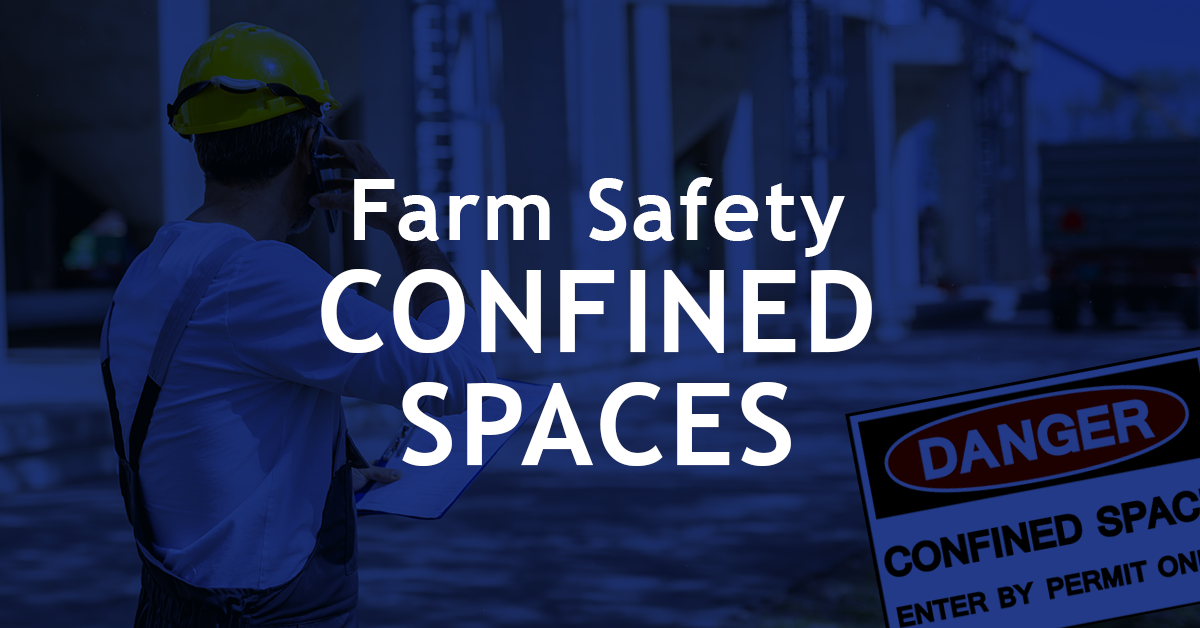
If you work on a farm, chances are you will be exposed to the hazards of confined spaces. So, what exactly is a confined space? Different jurisdictions might vary slightly on how they define a confined space, but I think WorkSafe BC defines it best as having the following characteristics:
- Is enclosed or partially enclosed
- Is not designed or intended for continuous human occupancy,
- Has limited or restricted means for entry or exit that may complicate the provision of first aid, evacuation, rescue, or other emergency response service, and
- Is large enough and so configured that a worker could enter to perform assigned work.
Some examples of confined space on the farm are:
- Grain bin
- Silos
- Manure storage facilities
- Hopper bottom feed bins
- Grain transport vehicles
- Septic tanks
- Fertilizer storage tanks
- Pump pits
- Attics & Crawl spaces
What Are The Hazards?
There are many different hazards that may be present in confined spaces, ranging from toxic environments to mechanical hazards. Lets look at some common ones that we might see on the farm.
Dangerous Gases
The breakdown of manure is a biological process, and factors such as temperature, humidity, and air flow can impact the release rate of gases produced during this process.
Hydrogen Sulfide - It has a distinct rotten egg smell and is heavier than air. After breathing this gas for a short time, your sense of smell becomes fatigued, and you can no longer detect an odor. At low concentrations H2S irritates the eyes and respiratory tract while at moderate levels, exposure causes headache, nausea, and dizziness. At high concentrations above 1000 – 2000 parts per million death is almost instantaneous. Hydrogen sulfide is heavier than air, so it can easily accumulate in low-lying areas of confined spaces.
Methane - A colorless and odorless gas produced during the decomposition of manure in storage. methane is flammable and potentially explosive. Methane is lighter than air, so it does not accumulate in low-lying areas of confined spaces.
Ammonia - Found in manure pits or aboveground tanks used for manure storage it has a strong odor that can irritate a person’s eyes or respiratory system.
Carbon Dioxide - A colorless and odorless gas associated with animal respiration and manure decomposition. Carbon dioxide can replace the oxygen in a confined space. If you breathe in air that contains high levels of carbon dioxide, carbon dioxide can replace the oxygen in your blood and may result in headaches, drowsiness, and death (after prolonged exposure). Carbon dioxide is heavier than air, so it also can accumulate in low-lying areas of confined spaces.
Mechanical Hazards
Mechanical equipment such as augers, mixers or rotating tanks can be dangerous to work near. Even when equipment is shut off someone else could accidentally turn it on. The machine could also contain remaining energy, such as accumulated pressure.
Engulfment Hazards - Grain that is being stored can be a risk because you could get trapped or buried. Grain can form “bridges” with empty spaces underneath them. If you walk on the surface of one of these bridges, it could collapse and bury or trap you. Bins and hoppers are especially dangerous. You could be trapped or crushed when material is accidentally discharged into an empty bin or hopper.
Drowning - If the confined space has liquid in it even as little as a few inches the potential for drowning exists. Workers have drowned in confined spaces after being knocked out by toxic gas, a lack of oxygen, or from a head injury that caused them to fall to the floor.
Manage The Hazards
- The first step is to identify what confined spaces you have and what hazards each confined space is likely to be present. Once you have identified them, post signs at the entrances of the confined space them so others will be aware and not enter them.
- The best way to eliminate being exposed to the hazard is not having to enter the confined space in the first place. Is it necessary that you enter the space or could you hire a trained contractor to complete the work needed in the confined space?
- If you do have to enter confined spaces, get trained! There is specialized equipment and planning that is needed to safely work in confined spaces. A good training program will let you know what you need and how to do it safely.
- Have a rescue plan in place. An unplanned rescue will probably be your LAST!





